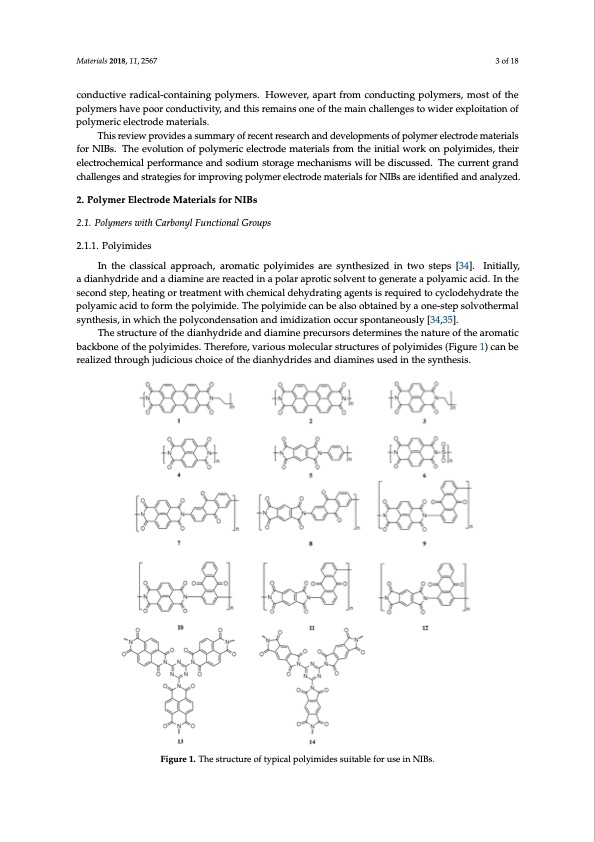
PDF Publication Title:
Text from PDF Page: 003
Materials 2018, 11, x FOR PEER REVIEW 3 of 20 Materials 2018, 11, 2567 3 of 18 radical‐containing polymers. However, apart from conducting polymers, most of the polymers have poor conductivity, and this remains one of the main challenges to wider exploitation of polymeric conductive radical-containing polymers. However, apart from conducting polymers, most of the electrode materials. polymers have poor conductivity, and this remains one of the main challenges to wider exploitation of This review provides a summary of recent research and developments of polymer electrode polymeric electrode materials. materials for NIBs. The evolution of polymeric electrode materials from the initial work on polyimides, This review provides a summary of recent research and developments of polymer electrode materials their electrochemical performance and sodium storage mechanisms will be discussed. The current for NIBs. The evolution of polymeric electrode materials from the initial work on polyimides, their grand challenges and strategies for improving polymer electrode materials for NIBs are identified and electrochemical performance and sodium storage mechanisms will be discussed. The current grand analyzed. challenges and strategies for improving polymer electrode materials for NIBs are identified and analyzed. 2. Polymer Electrode Materials for NIBs 2. Polymer Electrode Materials for NIBs 2.21.1P. oPloylymmeerrsswith Carboonnyyl lFFuunnctcitoinoanlaGlrGouropsups 2.1.1. Polyimides 2.1.1. Polyimides In the classical approach, aromatic polyimides are synthesized in two steps [34]. Initially, In the classical approach, aromatic polyimides are synthesized in two steps [34]. Initially, a a dianhydride and a diamine are reacted in a polar aprotic solvent to generate a polyamic acid. In the dianhydride and a diamine are reacted in a polar aprotic solvent to generate a polyamic acid. In the second step, heating or treatment with chemical dehydrating agents is required to cyclodehydrate the second step, heating or treatment with chemical dehydrating agents is required to cyclodehydrate the polyamic acid to form the polyimide. The polyimide can be also obtained by a one-step solvothermal polyamic acid to form the polyimide. The polyimide can be also obtained by a one‐step solvothermal synthesis, in which the polycondensation and imidization occur spontaneously [34,35]. synthesis, in which the polycondensation and imidization occur spontaneously [34,35]. The structure of the dianhydride and diamine precursors determines the nature of the aromatic The structure of the dianhydride and diamine precursors determines the nature of the aromatic backbone of the polyimides. Therefore, various molecular structures of polyimides (Figure 1) can be backbone of the polyimides. Therefore, various molecular structures of polyimides (Figure 1) can be realized through judicious choice of the dianhydrides and diamines used in the synthesis. realized through judicious choice of the dianhydrides and diamines used in the synthesis. Figure 1. The structure of typical polyimides suitable for use in NIBs.PDF Image | Polymer Electrode Materials for Sodium-ion Batteries

PDF Search Title:
Polymer Electrode Materials for Sodium-ion BatteriesOriginal File Name Searched:
materials-11-02567.pdfDIY PDF Search: Google It | Yahoo | Bing
Salgenx Redox Flow Battery Technology: Salt water flow battery technology with low cost and great energy density that can be used for power storage and thermal storage. Let us de-risk your production using our license. Our aqueous flow battery is less cost than Tesla Megapack and available faster. Redox flow battery. No membrane needed like with Vanadium, or Bromine. Salgenx flow battery
| CONTACT TEL: 608-238-6001 Email: greg@salgenx.com | RSS | AMP |